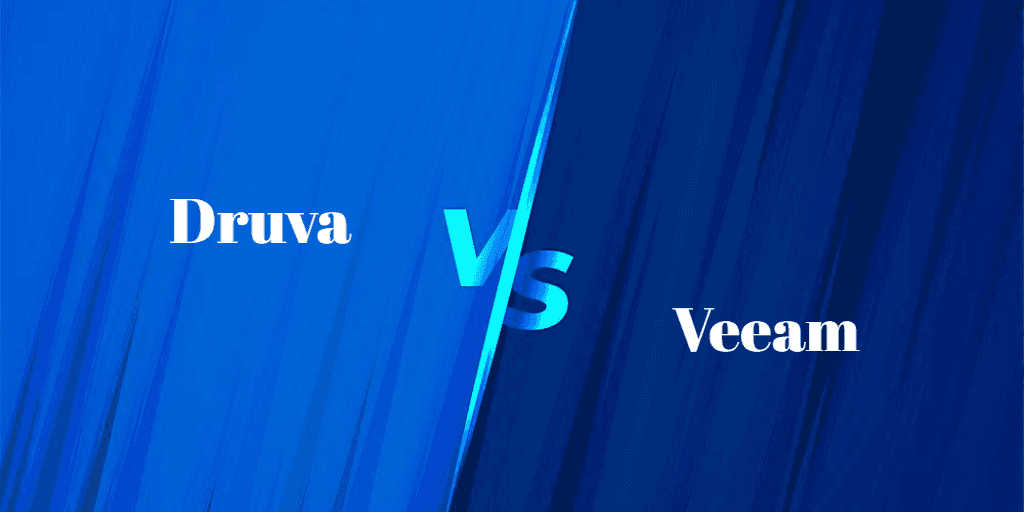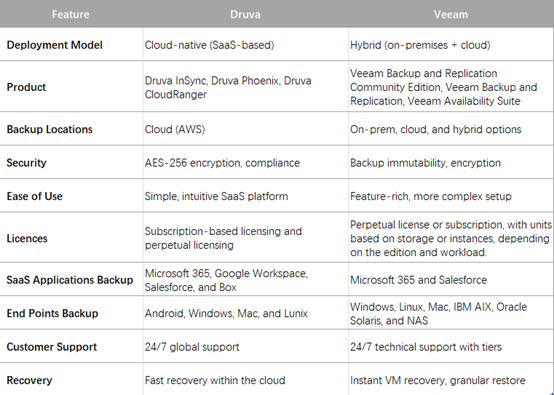Druva and Veeam come up often of the numerous backup solutions on the market. Both are leaders in their fields, but how do they solve problems differently?

Druva is a cloud-native data security solution built specifically for cloud environments. Founded in 2008, Druva is a provider of cloud-based backup, disaster recovery and archiving services.
With a Software-as-a-Service (SaaS) approach that eliminates the requirement for on-premises hardware, Druva is an attractive option for companies looking to simplify their IT setup while leveraging the scalability and flexibility of the cloud.
Veeam is a well-known leader in the backup space with a hybrid strategy for both on-premise and cloud systems.
Founded in 2006, Veeam is known for its high-performance backup options for virtual, physical and cloud-based workloads. Veeam supports complex infrastructures such as multi-cloud computing and cloud computing.

Both Druva and Veeam offers excellent choices, but they cater to different needs. Below is a detailed comparison of their features, produces, pricing, backup workloads, etc.

1. Cloud vs. Hybrid Approach
Druva is a fully cloud-native solution, which means that AWS is used to host all of its services. Because of this, it's perfect for companies who already run their operations mostly in the cloud and wish to minimize the expense and complexity of maintaining infrastructure on-site.
In contrast, Veeam is a hybrid system that works in both cloud and on-premises settings. This makes it more appropriate for companies that are moving to the cloud or have a combination of virtual and physical infrastructure.
2. Backup and Recovery Performance
Druva’s cloud-native architecture ensures rapid backup and recovery within cloud environments. It uses global deduplication, which significantly reduces the amount of data stored and transferred, resulting in faster recovery times.
Veeam offers near-instant recovery with its “Instant VM Recovery” feature, which allows virtual machines (VMs) to be brought back online in minutes. Additionally, Veeam provides granular recovery options, such as restoring individual files, making it an excellent choice for businesses with demanding recovery objectives.
3. Security and Compliance
Druva excels in security and compliance, with end-to-end encryption (both in transit and at rest) and support for industry-specific compliance needs such as GDPR, HIPAA, and SOC 2. Druva’s focus on cloud security makes it a top choice for industries like healthcare and finance.
Veeam also prioritizes security, with features like backup encryption and ransomware protection through backup immutability. However, its compliance features are more focused on the security of physical and hybrid environments rather than cloud-exclusive protection.
4. Ease of Use
Druva’s cloud-native SaaS model simplifies deployment and management, offering a user-friendly dashboard with automatic updates, eliminating manual maintenance.
Veeam, while feature-rich, is more complex due to its hybrid nature, requiring more technical expertise for setup and customization.
5. Scalability
Druva's good scalability is well known, and organizations can easily scale up or down based on their data protection needs without worrying about hardware limitations.
Veeam also scales well, but may require additional infrastructure, especially for on-premise deployments. However, it performs better in large hybrid environments.
🟡When Druva Is the Better Choice
🟢When Veeam Is the Better Choice
While Druva and Veeam are widely recognized in the backup and disaster recovery space, AOMEI Cyber Backup is emerging as a strong alternative, offering a cost-effective and user-friendly solution.
Designed to protect both physical and virtual environments, AOMEI Cyber Backup focuses on simplicity, flexibility, and affordability. It also provides following features:
Download AOMEI Cyber Backup to keep your data safe:
Step 1. Bind Device
Navigate to Source Device > VMware > + Add VMware Device. Then enter the following information, including device and user. Then click Confirm.
Step 2. Create New Task
Navigate to Backup Task > + Create New Task to schedule VMware backups.
Configure Task Name, Backup Type, Device, Target,Archive, Schedule and Backup Cleanup.
Step 3. Start Backup
Click Start Backup and select Add the schedule and start backup now, or Add the schedule only.
Step 4. Restore from Backup
Navigate to Restore section, you can easily recover a VM from backup.
✨Whether you're a small business with limited IT resources to manage or a mid-sized organization with a mix of physical and virtual infrastructures, AOMEI Cyber Backup provides a reliable, easy-to-use and affordable data protection option.
Choosing between Druva and Veeam depends largely on your business's infrastructure and backup needs. Both solutions are leaders in the industry, but the best choice will depend on whether you prioritize cloud simplicity or hybrid flexibility.
AOMEI Cyber Backup offers a powerful alternative, especially for organizations looking for a more cost-effective, straightforward solution.